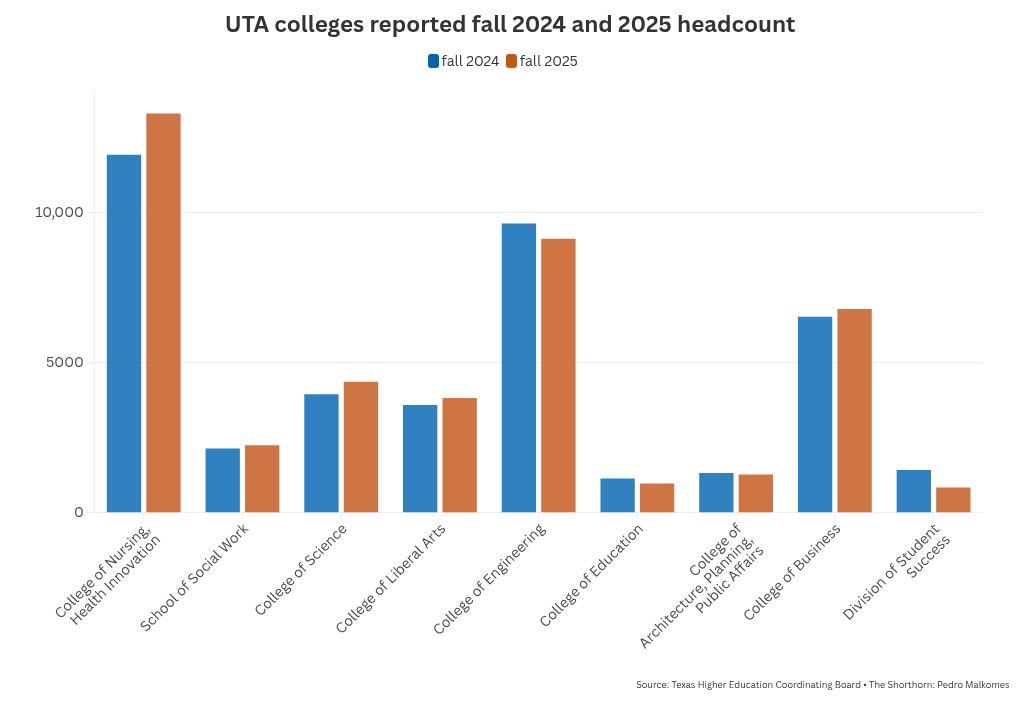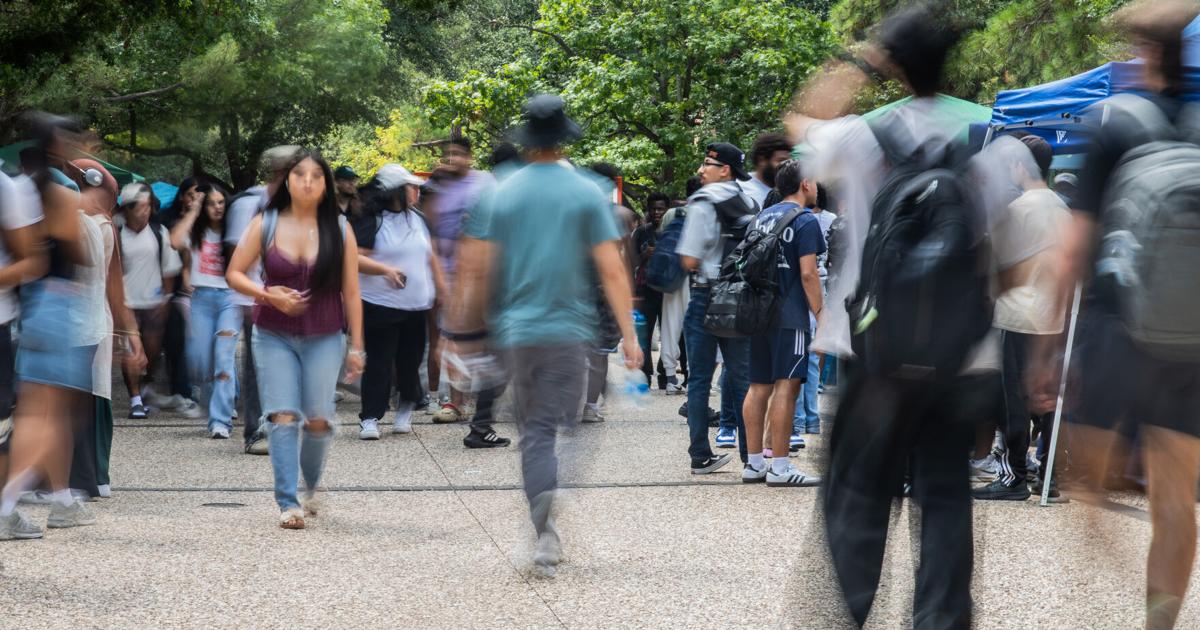Students gather on the University Center mall during Activity Fair Day on Aug. 27 at UTA. The College of Nursing and Health Innovation experienced the biggest increase in enrollment of UTA colleges from fall 2024 to fall 2025.
UTA reported 42,710 undergraduate and graduate students this fall, a 2.6% increase from last year bolstered by a record freshman class. Despite the overall growth, the university’s individual colleges have vastly different student enrollment.
The Shorthorn compiled enrollment data from each college and recorded which saw growth, which experienced a decrease and how changes in enrollment are shaping the colleges’ futures.

College of Nursing and Health Innovation
The College of Nursing and Health Innovation saw the most significant growth in fall enrollment — an 11.57% leap from 2024 — and continues to house the largest student population at UTA with 13,302 people in the college, according to Texas Higher Education Coordinating Board data.
Undergraduate nursing students make up the majority of that population, with graduate nursing students not far behind, said Jeffrey Taylor, executive director of the college’s Office of Enrollment and Student Services.
Other programs like kinesiology and public health only account for a fraction of enrollment, Taylor said.
Like most of UTA’s colleges, the College of Nursing and Health Innovation experienced a dip in enrollment after 2020, following the COVID-19 pandemic, but has been steadily climbing back since. In 2020, the college had 20,680 students enrolled, according to College of Nursing and Health Innovation internal data.
Post-COVID-19 challenges haven’t been exclusive to higher education.
Taylor said nursing as a whole may have been suffering from burnout issues during that time, and people were just working on “surviving,” not advancing their education.
However, new university students have been turning back to the program, which, accompanied by a growing need for nurses, is great for UTA, he said. While the college continues to grow back toward its peak enrollment, the physical limitations of having many students become more prevalent.
“One of the limitations is literally clinical sites, because we can’t bring them in and teach them how to be a nurse if we don’t have a hospital for them to go to to actually practice,” Taylor said.
With the opening of UTA West set for 2028, the college is looking for new clinical locations westward to continue expanding.
“We’ve got very robust on the undergrad side,” Taylor said. “I think the graduate side is probably where a lot of focus will be coming.”
College of Science
The College of Science has had a 10.6% increase in student enrollment since fall 2024, going from 3,940 students to 4,359 students, according to Texas Higher Education Coordinating Board data. Valerie Martinez, director of student success and recruitment in the College of Science, said that it was the second-highest enrollment increase this fall, after the College of Nursing and Health Innovation.
Martinez said the increases in enrollment are due to many factors, like changes in overall strategic planning of enrollment management across the university, a new academic recruiter that allowed the college to branch out into different markets, one-stop solution hubs, orientation programming and new science ambassadors.
“I don’t think it was just one thing that we did necessarily in the College of Science,” Martinez said. “I think it was just really a lot of little changes and things that multiple offices throughout the university did to contribute to the enrollment increase.”
The Division of Data Science within the college, one of the newer programs, has also boosted enrollment. Martinez said the 18-month program is one of the fastest-growing programs in the college.
“We’re the College of Science, and so I feel like innovation really kind of lies here,” Martinez said. “I always tell students that here in the College of Science, we have so many different resources.”
The college changed its Maverick Experience programming and involvement with academic departments within the recruitment process to give prospective students an idea of what it would be like in a specific major, Martinez said.
The College of Science also has the Life Science Building, which is currently being renovated. When it is finished in 2027, it will allow for more students in programs like biology.
“We were really strategic this year in monitoring class enrollment seat projections and really making sure that we had spaces for our students, and so that’s always kind of like the catch, you’ve got to make sure we have space for the students who we’re enrolling,” she said.
College of Business
Fernando Jaramillo, associate dean for academic affairs in the College of Business, said the college has had a 3.89% increase in enrollment this fall, with much of the growth coming from its undergraduate programs.
From new degrees like hospitality management and entrepreneurship to traditional degrees like accounting and management, degrees are created and maintained in accordance with the needs of students, Jaramillo said.
With a rising preference among students for online courses, the college has created more online courses, with its MBA program available completely online. The college is in the process of making its management and marketing programs 100% online as well, he said.
“Many of our students come from work, and many of them work on a full-time basis, so they cannot afford to drive to campus every day to take a class,” Jaramillo said. “So we have increased our portfolio of online delivery.”
College of Liberal Arts
The College of Liberal Arts had a 6.64% increase from fall 2024, according to Texas Higher Education Coordinating Board data.
The philosophy department had a 43% increase this fall. Linguistics and TESOL, Teachers of English to Speakers of Other Languages, had a 33% increase. The more typically popular departments, like history and geography, are continuing to hold “steady,” said Desirée Henderson, associate dean for education in the College of Liberal Arts.
Henderson said the increase is due to recruitment efforts. She said potential students are looking at liberal arts education and what it provides, which is the skills needed for their future careers.
“We’re really extremely happy to have that increase and really excited to see so many students on campus,” Henderson said.
The college used data tools to predict the number of students and what courses were needed. New sections were opened, specifically core courses, to accommodate the larger number of students.
“There’s a lot of moving parts, but it’s all really good news for the university and for the college as a whole,” Henderson said.
School of Social Work
The School of Social Work had a 5.01% increase in enrollment from fall 2024 to 2025, now having 2,244 students, according to Texas Higher Education Coordinating Board data. In 2024, the college had 2,137 students.
Graduate students currently account for the majority of the college’s enrollment and have remained the largest group for at least five years. The college has grown steadily since 2021, only experiencing a slight enrollment dip in fall 2023, then rising again.
Despite uncertainty surrounding collegiate funding from the federal government, Tonya Hansel, School of Social Work associate dean for research, said the political landscape is nothing new, and the profession of social work is positioned to lower costs while keeping social services available.
“We are leading innovation in how we can do more with less while continuing to advocate for the dignity and worth of every person,” Hansel said in an email.
College of Engineering
Despite remaining the second-largest body of students on campus, the College of Engineering experienced a 5.25% dip in enrollment, according to Texas Higher Education Coordinating Board data. The college currently reports 9,127 students, compared to 9,633 in fall 2024.
College of Architecture, Planning and Public Affairs
The College of Architecture, Planning and Public Affairs experienced a 3.65% decrease in enrollment in fall 2025, now having 1,268 students compared to 1,316 in 2024, according to Texas Higher Education Coordinating Board data.
College of Education
The College of Education saw a 14.32% decrease in enrollment, with 162 fewer students than in fall 2024.
The Division of Student Success
The Division of Student Success experienced a 41.21% decrease in enrollment, going from 1,422 students in fall 2024 to 836 in 2025, according to Texas Higher Education Coordinating Board Data.
@atclements03 @PMalkomes


